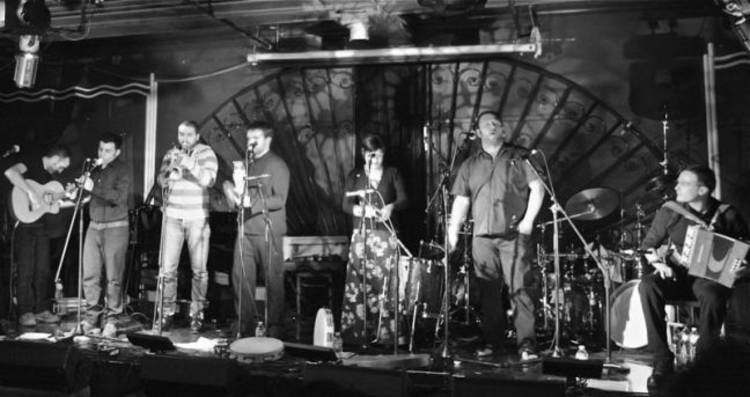


Canzoniere Grecanico Salentino, with skill and panache, pulls off a tricky artistic feat: the band from Lecce, in Puglia, makes a traditional music rooted in a vanished culture connect with, and excite, contemporary audiences. Canzionere Grecanico Salentino – CGS for short -- specializes in the pizzica tarantata, a centuries-old folk idiom that originated as ritual healing music. The band honors pizzica’s traditions but avoids the pitfall of sterile, folkloristic purism. On recordings and in their shows, CGS offers the sophistication of a jazz ensemble and the energy and power of a great rock band.
Founded in 1975 by the writer Rina Durante, CGS is Italy’s oldest traditional music ensemble. But the band has gone through numerous changes in its three-decade- plus history. In 2007, Daniele Durante (Rina’s cousin) turned the leadership of CGS over to his son Mauro, a conservatory-trained violinist who also was schooled in the traditional music of Salento (the sub-peninsula sometimes referred to as the “heel” of the Italian “boot.”) Under Mauro’s leadership, the band – seven pieces plus a dancer – has won numerous awards, performed widely in Italy and abroad, and released two exceptional albums, Focu d’Amore, in 2010, and now, Pizzica Indiavolata.
In 2011, CGS played their first North American tour, covering 11 cities in the U.S. and Canada. The tour gained them new fans and won rave reviews from critics and other musicians. Their explosive set was a highlight of the 2012 edition of GlobalFEST, New York’s leading world music festival.
CGS returns in 2013 for a 13-city North American tour that begins February 1 in New York City, at the Michael Schimmel Center for the Arts in Manhattan. The tour ends with the band’s appearance at the renowned SXSW (South by Southwest) festival in Austin, Texas.
Having seen CGS perform several times, I’m delighted that they’re coming back, and with a terrific new album. Pizzica Indiavolata, comprising 13 tracks written by Mauro Durante or adapted by him from traditional material, mixes soulful ballads with hard-driving, ecstatic pizzica. The album showcases the talents of the individual musicians: Mauro, on violin, percussion and vocals; lead singer Maria Mazzotta; multi-instrumentalist Giulio Bianco; bouzouki player and singer Emanuele Licci; guitarist Luca Tarantino; diatonic accordionist Massimiliano Morabito, and singer-percussionist Giancarlo Paglialunga. Each band member gets to shine, but the lead or solo turns always are in the service of the distinctive ensemble sound.
The album also features guest appearances by the Malian kora virtuoso Ballaké Sissoko and the Anglo-Italian singer-songwriter Piers Faccini, whose contributions fit seamlessly in the band’s sound.
On the eve of the forthcoming CGS tour, I spoke with Mauro Durante about the new recording.
“Pizzica Indiavolata is the seventeenth album in CGS's history,” he noted, and the second, after Focu d’amore, with him as the band’s leader. “It’s the culmination of a two-year journey by a band that has grown up together, touring Europe, Canada and the United States. A band that feels proud and ready to represent this music all over the world, offering traditional tracks re- arranged and presented with a modern touch, together with new, original compositions.”
The words to the album’s opening number, “Nu te Fermare,” address an issue that’s particularly urgent in today’s Italy, but not only there -- the frustration of young people who get an education and find there are no jobs for them. “When I compose new songs,” Mauro said, “I often am inspired by melodies, rhythms or other suggestions that come from the tradition, but I try to express my own ideas and emotions, describing with music and lyrics what I see and live everyday, and what I feel.” brilliant
“I have been lucky,” he continued, “to grow up in a family that made me love this traditional repertoire, and I have always felt absorbed by this wonderful musical world. Then I studied and practiced a lot, so I could analyze and understand the complexity of a culture that comes from the past.”
Pizzica originally was the ritual music of tarantismo, a spiritual-therapeutic practice of poor Salento peasants; it was played to exorcise the maladies, physical and psychological, supposedly caused by the poisonous bite of the tarantula. Mauro observes that although tarantismo has died out, its music, pizzica, is thriving. “Traditional music has always satisfied an immediate need, emerging from what we experience in our lives. That's why I believe that it’s important for us to write and play the reality of our own lives today, to renew this music so that it stays alive.”
Mauro said that the new album’s title comes from the repertoire of Luigi Stifani, a celebrated Salentine violinist. Stifani accompanied the anthropologist Ernesto De Martino when De Martino, in 1959, went to Salento to research tarantismo for his famous study, The Land of Remorse. The pizzica indiavolata, said Mauro, was Stifani’s “strongest” pizzica, the one that had the most powerful therapeutic effect on the tarantati, those “bitten” by the tarantula. Stifani, accompanied by Tora Marzo on tamburello (large tambourine), diatonic accordionist Pasquale Zizzari and guitarist Luigi Cecere, formed the legendary Orchestrina Terapeutica.
“We made our own version of the track,” Mauro said, “creating a sort of new ‘orchestrina terapeutica.’ "
CGS’s “Pizzica Indiavolata” is a thrilling performance led by Mauro on violin that surges, peaks and subsides, only to build momentum and hit new peaks of rhythmic intensity. It’s a wild ride. “Pizzica Indiavolata,” said Mauro, “is music therapy, coming from the tradition of tarantismo, composed to exorcise, with a sound both ancestral and modern, the evils of our days. We are living in tough times, it's hard to find a job, to feel realized and gratified, but it's fundamental not to surrender, to believe in your own ideas and make your voice heard.”
Visit Canzoniere Grecanico Salentino [2] online for information about the band and their forthcoming North American tour.
Source URL: http://440468.6bgr9ubv.asia/magazine/focus/art-culture/article/pizzica-indiavolata
Links
[1] http://440468.6bgr9ubv.asia/files/canzonieresalentino1358998593jpg
[2] http://www.canzonieregrecanicosalentino.net